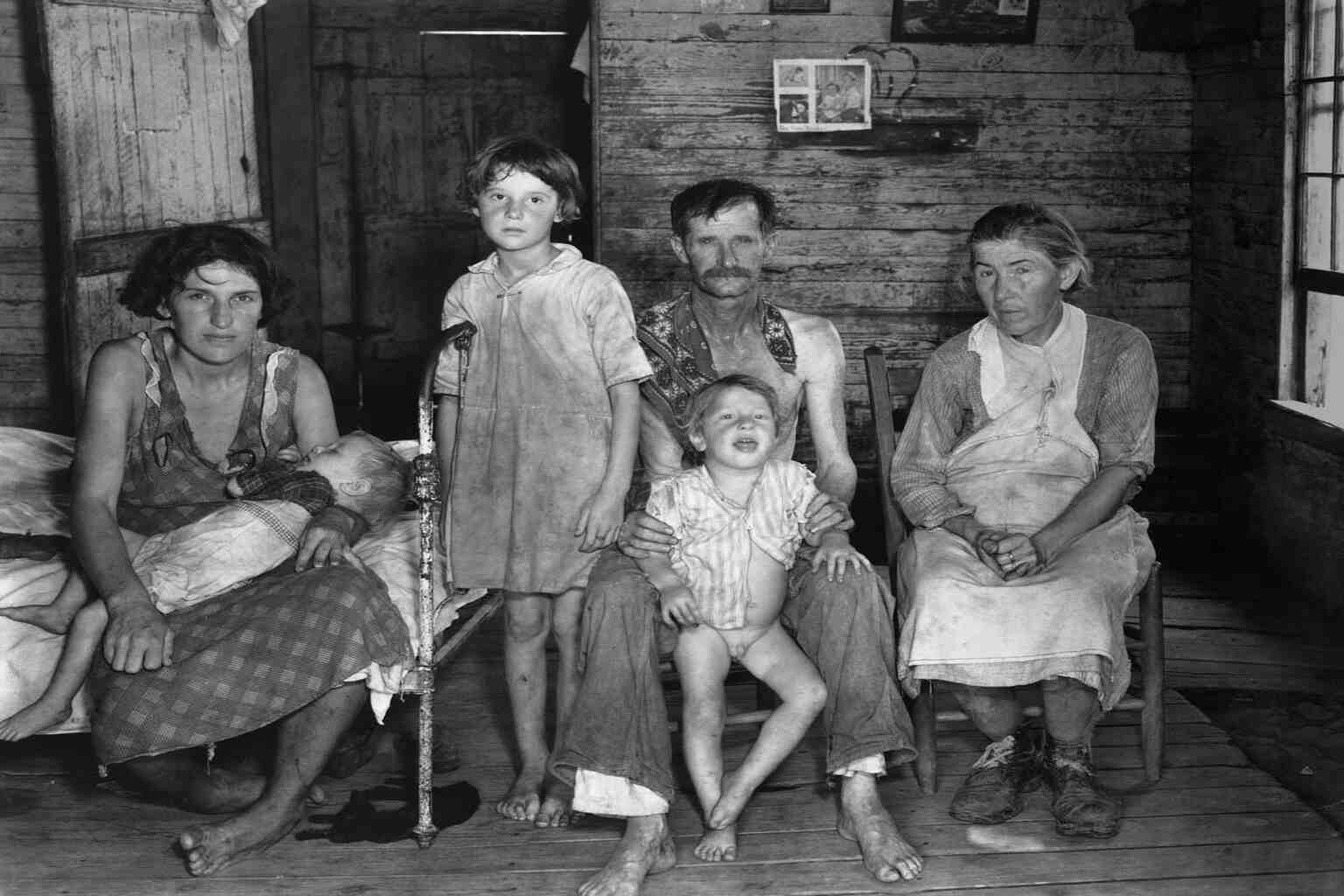The Great Depression was a worldwide economic downturn that started off as an ordinary recession in the summer of 1929. The economic downturn worsened by the end of 1929 and lasted a full decade, until about 1939. And while the causes of the great depression are still hotly debated by economists today, all agree that it was the most severe depression ever experienced by the Western world.
The impact of the Great Depression was so severe that it caused major upheavals in economic institutions, macroeconomic policy, and even economic theory. Although it had its origin in the United States, its effect was global, causing drastic declines in industrial production, high levels of unemployment, and acute deflation across the globe. For Americans, it was the harshest period they had faced since the Civil War.
The Great Depression, reason says, was caused by a confluence of many factors. While the primary causes are still very much a contentious subject, most economists and historians agree that there were a few explanations for the causes that cannot be disputed. In this article, we have focused on the 5 causes of the Great Depression that are indisputable.
Explanations For The Causes Of The Great Depression
What caused the Great Depression is a subject that is still hotly debated today. The causes of the great depression are many, but among economists, three schools of thought have emerged as to the main causes of the depression. They are the Keynesian, the Monetarist and the International explanations and taken together, they provide us with the 5 main reasons for the depth and scale of the Great Depression
1. The fall in demand
One of the main Great Depression causes stemmed from a fall in demand for goods. The depression started as a recession. During recessionary periods, the demand for products falls, and this is exactly what happened. As the fall in demand became severe, businesses and companies were forced to lay off workers because there was no demand for their products. When workers are unemployed and the future remains uncertain, they spend less, and this is what happened in the summer of 1929.
Keynesian theory, as outlined by John Maynard Keynes, the British economist, held that in a modern economy, demand could remain low for an indefinite period. During this time, unemployed workers will spend less, businesses will cut back on production since there is no demand, and more workers will lose jobs. This aspect of the theory was borne out during the Great Depression.
According to Keynes, when there is a fall in demand, the only way to increase employment was for the government to increase spending radically so as to compensate for the decrease in spending by consumers and businesses. It called for the creation of new money by the government for it to borrow and spend, and the cutting of taxes. The combination of increased government spending and a cut in taxes would eventually stimulate demand and get the economy out of the depression.
Without a doubt, the fall in consumer demand led to large-scale unemployment, which led to businesses cutting back on production, causing many businesses to fail, exacerbating the problem. As businesses failed, they were unable to repay bank loans and this led to pressure on the banks and led to bank failures.
2. The failure of banks
As the recession deepened, more and more businesses began to fail. This meant that an increasing number of businesses went bankrupt and were unable to repay their bank loans. As banks began to write off the loans, their ability to stay liquid was affected, and they themselves began to fail.
This was one of the main causes of the financial crisis, according to economists of the Monetarist school of thought. Their theory was that the length and severity of the Great Depression resulted from the unwillingness of the Federal Reserve System to support banks and prevent their failures.
The Federal Reserve System in the US was established by Congress in 1913. The reason for its creation was to prevent bank failures, which could be caused by a “run” on a bank. A “run” occurred when many customers withdrew their deposits from a bank in cash. When a run became severe, the bank would run out of cash and would be unable to pay off its customers, eventually declaring bankruptcy. In these cases, the Federal Reserve was supposed to supply the banks with enough cash to support their needs and prevent a bank failure.
According to Milton Friedman and Anna Schwartz, the Federal Reserve in the 1930s refused to support banks that they thought would be unable to repay them. This caused an increasing number of banks to fail and go bankrupt, further eroding confidence.
3. The failure of the Federal Reserve System
According to Milton Friedman and Anna Schwartz, another cause of the Great Depression was the failure of the Federal Reserve to keep interest rates low so as to encourage businesses. By increasing interest rates and keeping them high when banks began to fail in early 1930, the Federal Reserve refused to support them.
The Monetarists claim that the depression was prolonged because banks played it safe and didn’t lend money to businesses. After 1933, bankers were even more reluctant to make new loans. These were made only under the safest and most conservative terms, mainly because the banks believed that the Federal Reserve would not support them if they got into trouble. In addition to this, once things began to improve slightly in 1936, the Federal Reserve actually raised interest rates on loans because it feared inflation.
With its failure to support banks and by keeping interest rates high, the Federal Reserve System shared a large responsibility for deepening and prolonging the Great Depression.
RELATED READING: 15 Greatest Love Letters Ever Written In History
4. The problem of the gold standard
This theory is one of the main historical causes of the economic downturn known as the Great Depression and is seen as part of a larger global depression. Its severity in the United States was attributable to the Federal Reserve being obliged to follow the rules of the gold standard.
Barry Eichengreen and Harold James published their theory in “Golden Fetters: The Gold Standard and the Great Depression, 1919-1932”. According to them, one of the main causes of the Great Depression worldwide was the return of European nations to the gold standard after World War I. This was a series of monetary rules that established fixed rates of exchange between nations of the developed world. The rates of exchange linked individual currencies to the price of an ounce of gold. The standard restricted the amount of money that could be created and lent.
Post the war, the industrialized countries went back to the gold standard, but the economic realities had changed. Going back to pre-war exchange rates caused many countries great hardship. Some nations couldn’t produce as much as they had before the war and could not earn enough gold back from exports to support their currencies. This led to bank failures, and the problems were magnified to such an extent that countries began abandoning the gold standard.
Fear that the United States, too, would abandon the gold standard caused many foreign depositors to withdraw their funds, and this led to a run on US banks. The Federal Reserve stuck by its commitments to the gold standard and raised interest rates in an attempt to attract dollar investments. The higher interest rates further put the brakes on the economy that was already well into a recession.
5. The crash of 1929
Most keen observers of economics and history suspect that the economic collapse that was the harbinger of the Great Depression was the Wall Street crash of 1929. The crash came after an unprecedented boom that lasted through most of the 1920s and created a speculative bubble. The boom made scores of people believe that making large amounts of money in the stock market was easy, and many put their life savings and even mortgaged their homes to invest in the market.
By the end of the decade, hundreds of millions of shares were being carried on margin. This meant that their purchase was financed by loans that had to be repaid. In financial terms, a speculative bubble was created. When the market decline began, more and more panicked investors were forced to liquidate their holdings and this led to a further panic and a decline in prices. The bubble had burst.
Between September and November 1929, the market declined by 33%, and this resulted in a colossal erosion of confidence in the economy among both businesses and individuals. This resulted in a decrease in consumer spending and business investments, which in turn led to reduced industrial output and job losses.
Between 1929 and 1933, industrial production fell by almost 47% and the GDP declined by 30% with 20% unemployment levels. One fifth or 20% of the banks in existence in 1930, around 5000 in total, had failed by 1933.
To the casual observer, it all began with the crash of 1929.
Conclusion
Apart from the causes centered around events and policies, there are a number of other factors that also contributed to the financial crisis. The Smoot-Hawley Tariff reduced both imports and exports. President Hoover initially, and then President Roosevelt, instituted policies that, while well meaning, prevented the economy from improving.
It was only when the American government began to spend increasing amounts to prepare for World War 2, did unemployment fall to normal levels. This statistic, as well as the length of the depression seemed to confirm the validity of Keynesian theory and it was increasingly accepted by economists, politicians and historians.
Research today, continues to add to the body of Great Depression history and deepen our understanding of it. Other theories have also been touted, and there is no single cause that is behind the worst economic crisis in modern times. Rather, it would be accurate to say that it was caused by a confluence of many factors. Take an economic downturn, add to it some misunderstood systemic risks, and mix in some misguided policies brought on by a lack of understanding of economics, and you have a recipe for a disaster.
5 Cultural Taboos That Make Total Sense Once You Know The History




